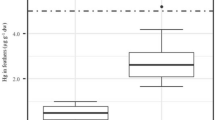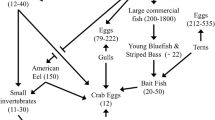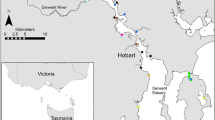Abstract.
Mercury exposure was examined in adults and nestlings of ospreys (Pandion haliaetus) from lakes, rivers, and hydroelectric reservoirs in northern Québec between 1989 and 1991 by assessing the amount of mercury transferred from fish to ospreys, which are voracious fish-eaters. The high mercury concentrations detected in adult feathers and tissues (feathers, blood, liver, kidneys, muscles, brain) of nestlings indicate an increase in mercury availability at recently constructed hydroelectric reservoirs (10–12 years for the La Grande-2 Reservoir). With mean total mercury levels of 37.3 mg/kg and 1.9 mg/kg in feathers (dry weight) and in blood (wet weight), respectively, contamination rates were, in both tissues, five times higher for chicks born near the La Grande Reservoirs (western sector) than in those reared in natural habitats. Furthermore, the mean quantity of total mercury in 40-day-old chicks reared near a reservoir was 10.5 mg, compared with to 1.6 mg for those reared in a natural environment.
Modeling of mercury transfer from fish to osprey nestlings showed that the mercury level in chicks' blood provides a good estimate of mercury concentrations in ingested food. In addition, the relationship between mercury concentrations in the blood and that in feathers indicates that substantial biomagnification of mercury occurs from the ingested dose to the feathers. The intensity of this biomagnification varies with the age of the chicks and reaches a maximum value as the flight feathers start to form (at 20–25 days of age) declining thereafter until the bird is 45 days old and growth of those feathers is complete.
Nevertheless, the mean number of young fledged on reservoirs where mercury exposure is greatest (>40 mg/kg of Hg in chicks' feathers) did not differ (1.6 ± 0.7) from that observed elsewhere in built-up environments (1.9 ± 0.7) or in natural habitats (2.0 ± 0.7) (H = 4.39; p = 0.11). Storage of mercury in growing feathers (86% of all mercury in osprey) prevents accumulation in living tissues, thereby protecting the chick from related toxic effects. However, toxicological problems may arise after fledging. In particular, attention should be paid to postfledging survival before concluding that mercury exposure is insufficiently high in Osprey young reared at reservoirs.
Similar content being viewed by others
Author information
Authors and Affiliations
Additional information
Received: 18 April 1997/Accepted: 3 January 1998
Rights and permissions
About this article
Cite this article
DesGranges, JL., Rodrigue, J., Tardif, B. et al. Mercury Accumulation and Biomagnification in Ospreys (Pandion haliaetus) in the James Bay and Hudson Bay Regions of Québec. Arch. Environ. Contam. Toxicol. 35, 330–341 (1998). https://doi.org/10.1007/s002449900384
Issue Date:
DOI: https://doi.org/10.1007/s002449900384




